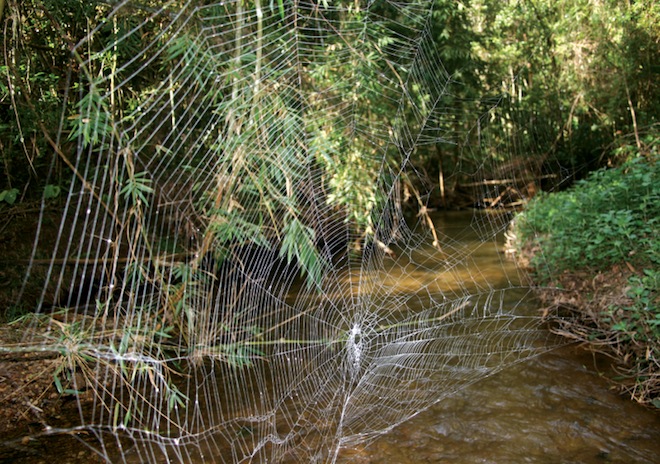Spider-Man might be a fictional superhero, but at least two of his tricks exist in the real world. Now, scientists have shown that it’s possible spin silk strong enough to stop a train, and are crafting a new super-sensory suit that warns its wearer when someone — or something — is approaching.
First, three graduate students decided to myth-bust a scene from the second Spider-Man movie. In it, Spider-Man slings webbing from the front of a four-car subway train and stops it from plummeting into a river. The team, from the University of Leicester in the U.K., calculated that some spider silk is, in fact, strong enough to stop a runaway train, and published their results in the most recent issue of Journal of Physics Special Topics.
First, the team calculated how much four R160 New York City subway cars — packed with a total of 984 people — would weigh (about 200,000 kilograms, or roughly 10 Atlas V rockets). Then, they calculated how fast the train was going (24 meters per second, or about 53 miles per hour) and how much resistance the track would have offered as it charged forward (negligible). From there, they could work out how much force the webbing would have needed to exert upon the train to stop it: about 300,000 Newtons, or about 12 times the amount of force exerted by a large American alligator as its jaws snap shut.
After considering the relative geometry of the train, webs, and buildings used to anchor the silk, the team calculated the amount of stiffness, or tensile strength, required to hold the train in place without snapping. That value is known as Young’s modulus, a measure of the stiffness in elastic materials, and works out to be 3.12 gigapascals (one Pascal = 1 Newton applied over a square meter).
Turns out, orb-weaving spiders produce silk that ranges in strength from 1.5 to 12 gigapascals — meaning that yes, Spider-Man could have stopped a moving train by flinging sticky silk at it. Coincidentally, the properties of the silk produced by Darwin’s Bark Spider (Caerostris darwini), an arachnid that lives in Madagascar and spins the largest webs observed (sometimes hanging from 25-meter long anchor threads), match those of the webbing Spider-Man deployed in this scene.
But it isn’t just Spider-Man’s silk that could be real. With the help of a new suit, the superhero’s ability to sense approaching people could also make the transition into reality. Victor Mateevitsi, a graduate student at the University of Illinois at Chicago, has built a suit that alerts its wearer to approaching humans. Called SpiderSense, the suit uses a suite of built-in microphones to sense the surrounding environment.
The microphones transmit high-frequency sound waves and monitor waves reflected by nearby objects. When a person or object approaches, the microphones can sense it, and they respond by producing pressure in the area of the suit closest to the object. Mateevitsi envisions using the technology to help the visually impaired, as well as cyclists dealing with road traffic, New Scientist reported.
Source: Wired USA


Recent Comments